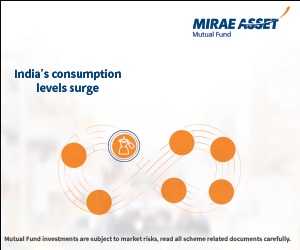Edelweiss Maiden Opportunities Fund Series 1 NFO aims to create wealth from IPOs

Initial Public Offerings garnered huge interest from investors in 2017. More than Rs 70,000 Crores, a record amount, was raised from 38 offerings. Companies from 18 different sectors raised funds through IPOs in Fiscal Year to date, 2018. 2017 saw record participation by Foreign Institutional Investors (FIIs) in IPOs – FIIs pumped in $7 billion in Indian IPOs. In fact, FII flows to the primary market (IPO) were higher than FII flows to the secondary market in 2017. IPOs contribution to overall market cap reached 3% (in December 2017), a seven year high.
Edelweiss Mutual Fund’s new fund offer, Edelweiss Maiden Opportunities Fund – Series 1, aims to leverage the potential of IPOs by investing in recently listed securities as well as upcoming IPOs. Edelweiss Maiden Opportunities Fund – Series 1 is a close ended scheme maturing on June 28th, 2021. The minimum subscription amount is Rs 5,000. The scheme will available for both growth and dividend options. The NFO has been open since February 2 and will close for subscription February 16, 2018.
Why is investing in IPOs a good idea
- The macros of Indian economy are strong and it is among the fastest growing economies in the world. Though the GDP growth may slip to 6.75% in FY 2018, it will be 7 to 7.5% in FY 2019 as per the Economic Survey. The IMF sees India’s GDP growth at 7.8% in FY 2019 beating even China. Though there is a slight slippage in fiscal deficit in the 2018 Budget, India has been on a path of fiscal consolidation over the last few years. There is a lot of interest in India’s growth story among foreign and domestic investors
- There is a favorable climate for business in general and capital markets in particular in the current political regime. The Government has instituted a number of structural reforms like Real Estate Regulation Authority (RERA), Goods and Services Tax (GST), Insolvency and Transparency code, Digital India program etc. These reforms have increased confidence of global investors in India.
- IPOs have been very profitable for investors. Investors got very handsome returns from IPO listings in 2017 – a lot of IPOs doubled the wealth of investors. Many investors made more than 30% profit just from listing gains (the difference list price and offer price) – the highest listing gain was more than 100%. Many shares are now trading (as February 5, 2018) significantly higher than the listing price.
- The chart below shows that, BSE IPO index outperformed the CNX Nifty 500 Total Returns Index by 104% over the past few years.
![Mutual Funds - BSE IPO index outperformed the CNX Nifty 500 Mutual Funds - BSE IPO index outperformed the CNX Nifty 500]()
Source: Edelweiss Mutual Fund
- Companies going public have earnings momentum. The earnings momentum can generate significantly higher returns for investors over and above the listing gains, if investors remain invested for a sufficiently long period of time. The table below shows some IPOs, which gained 10% or more from the listing price (we only looked at IPOs whose offer sizes were over Rs 500 Crores).
![Mutual Funds - IPOs, which gained 10% or more from the listing price Mutual Funds - IPOs, which gained 10% or more from the listing price]()
Source: Moneycontrol.com, * As on February 5, 2018
Investing in IPOs has the potential to generate substantial wealth for investors in the medium to long term.
Outlook for IPOs going forward
The primary market will continue to remain buoyant in 2018 and beyond for the following reasons.
- Private capex spending has been very low in India over the last few years and there is a pent up demand for capital to drive business growth. Given the buoyancy in the stock market, companies may want to tap the stock market through IPOs to fund their growth investments.
- The last 2 years saw a number of conglomerates unlocking value by listing their subsidiaries (e.g. listing insurance subsidiaries of financial services companies). This trend is likely to continue in the future.
- More than $70 billion was invested in India through the Private Equity (PE) / Venture Capital (VC) route from 2010 to 2015. Due to the buoyancy in the primary market over the last 2 years, most PE/VC investors will look to exit their investments through IPOs.
![Mutual Funds - PE/VC Investments in India and PE/VC Exits through IPOs Mutual Funds - PE/VC Investments in India and PE/VC Exits through IPOs]()
Source: Edelweiss Mutual Fund
- On the capital supply side, the EPFO is expected to increase its equity allocation from 15% to 25%. Individual investors are shifting from physical to financial assets, a trend which accelerated post demonetization. An SIP book swelling to Rs. 6200 crore per month, indicates that Indian investor is getting mature and sophisticated, which augurs well for both the primary and secondary market
Given the above factors the IPO market is expected to remain buoyant. Radhika Gupta, CEO Edelweiss AMC, in her interview with Advisorkhoj, expects “IPO activity in the range of INR 70,000 – 75,000 crore with an upward bias if the markets continue to be supportive. The trend towards larger IPOs will continue, and there will be broader industry participation than that seen in 2017 as new sectors come to market”.
Investment Strategy of Edelweiss Maiden Opportunities Fund – Series 1
Upto 80% of the assets under management shall be invested in maiden ideas from recently listed companies. Upto 15% will be invested in new IPOs to capture listing and future potential gains. Upto 5% of the portfolio will be used to buy long dated put options to hedge market risk. We think the market may be volatile in 2018 and the derivatives strategy of the fund, will provide some downside risk protection for investors while remaining invested in stocks for the tenure of the fund. Systematic rebalancing of portfolio will be done to ensure profit booking through dividend payouts.
Some of the key features of the investment strategy, as enumerated by Radhika Gupta in her interview with Advisorkhoj are as follows:-
- Portfolio will be constructed by analyzing companies by using a process driven approach.
- The stock weights will be in the range of 1% to 4% at the time of entry depending upon the quality of business, valuations and cyclicality of the sector.
- The fund will hold on an average 20 to 30 stocks.
- Holding period in such stocks will be in 18 to 24 months range depending on the qualitative aspects.
Why invest in Edelweiss Maiden Opportunities Fund instead of directly subscribing to IPOs?
Oversubscription may result in not getting allotments:
2017 saw huge oversubscriptions in IPOs. When an IPO gets heavily over-subscribed some retail investors may not get allotment. In IPOs the process of allotment is different for qualified institutional buyers (QIBs), retail investors and non institutional buyers. If the number of retail applications are more than the shares on offer for retail investors then the maximum number of retail allottees are determined by the maximum number of shares on offer for retail and the minimum lot size. If the number of retail applicants is more than the maximum number of retail allottees, then allotment is made by draw of lots. Mutual funds, on the other hand, are QIBs and they get proportional allotment based on oversubscription.Not all IPOs are investment worthy:
Not all IPOs create wealth for investors. Quite a few IPOs made listing losses in 2017 and some more have given negative returns till date. Mutual funds are managed by professional fund managers who have stock picking expertise and are supported by the organizational processes of the AMC.Market exit is important:
Most investors exit IPOs immediately after pocketing listing gains. However, substantial gains can be made by timing the exit prudently. Radhika Gupta of Edelweiss interview with Advisorkhoj said, “IPO activity remains buoyant during years when equity market and economy is doing well. This theme is cyclical in nature. A close ended fund will be able to capture this theme and time the exit in a better way as compared to an open-ended fund. A closed-ended fund gives better predictability and holding capacity to the fund manager – Best suited for a theme like IPO investing. A small size close ended fund can participate in IPO efficiently given the higher exposure”.
Why invest in Edelweiss Maiden Opportunities Fund instead of an open ended diversified equity fund?
Diversified equity funds also invest in IPOs, but their average exposure to IPOs is quite small. A dedicated fund investing in recent IPOs provides better access and thereby maximizing gains for investors.
Conclusion
Edelweiss Maiden Opportunities Fund – Series 1is an innovative offering from Edelweiss Mutual Fund which will enable investors to access the exciting IPO market in India. Investors should read the offer document of fund carefully to understand the risk factors or consult with their financial advisors before investing.
Mutual Fund Investments are subject to market risk, read all scheme related documents carefully.
Queries
-
What is the benefit of mutual fund STP
Aug 29, 2019
-
How much to invest to meet target amount of Rs 2 Crores
Aug 26, 2019
-
Can I achieve my financial goals with my current mutual fund investments
Aug 24, 2019
-
Can you tell me return of various indices
Aug 19, 2019
-
What would be the post tax return on different investments
Aug 18, 2019
-
Which Principal Mutual Fund scheme will be suitable for my retirement corpus
Aug 16, 2019
-
What is the minimum holding period for availing NCD interest
Aug 4, 2019
Top Performing Mutual Funds
Recommended Reading
Fund News
-
HDFC Mutual Fund launches HDFC CRISIL IBX Financial Services 3 to 6 Months Debt Index Fund
Apr 28, 2025 by Advisorkhoj Team
-
DSP Mutual Fund launches DSP Silver ETF Fund of Fund
Apr 28, 2025 by Advisorkhoj Team
-
Edelweiss Mutual Fund launches Edelweiss BSE Internet Economy Index Fund
Apr 25, 2025 by Advisorkhoj Team
-
Bajaj Finserv Mutual Fund launches Bajaj Finserv Nifty 50 Index Fund
Apr 25, 2025 by Advisorkhoj Team
-
SBI Mutual Fund launches SBI Income Plus Arbitrage Active FOF
Apr 23, 2025 by Advisorkhoj Team
















